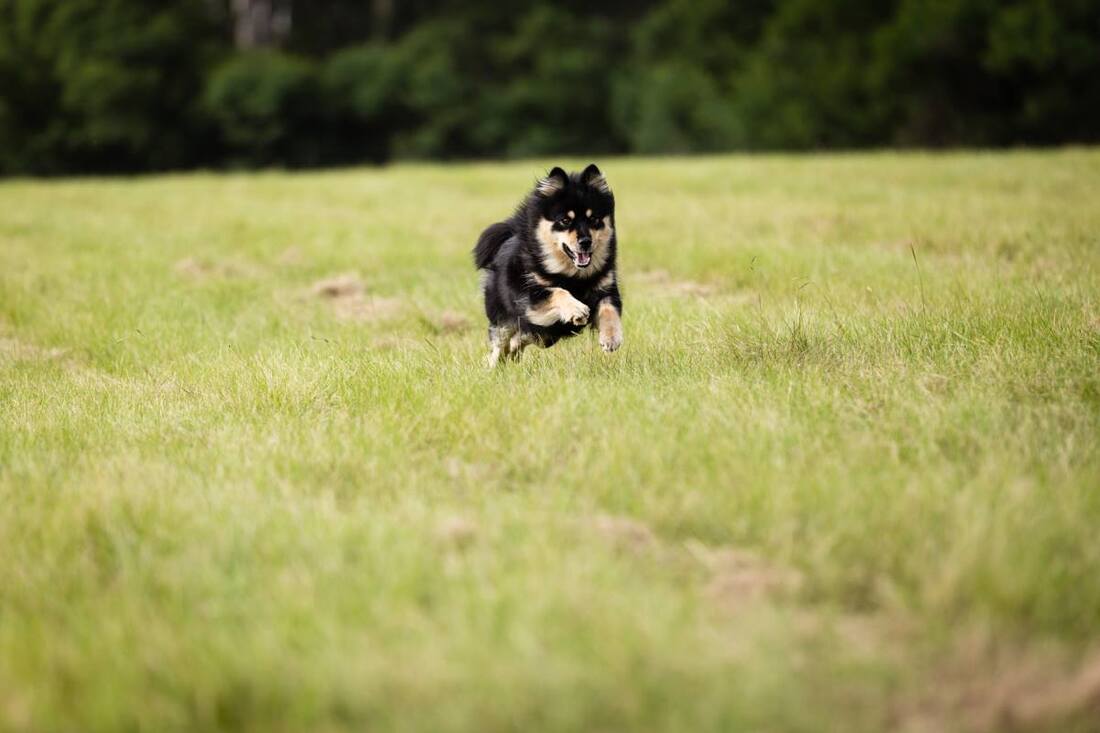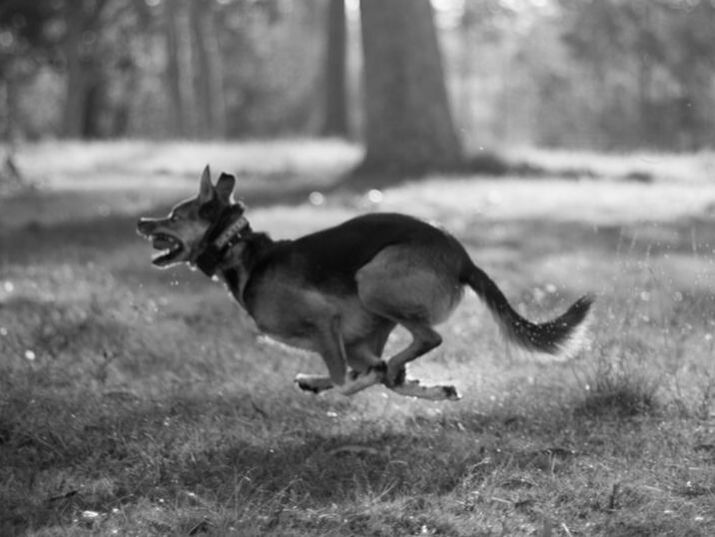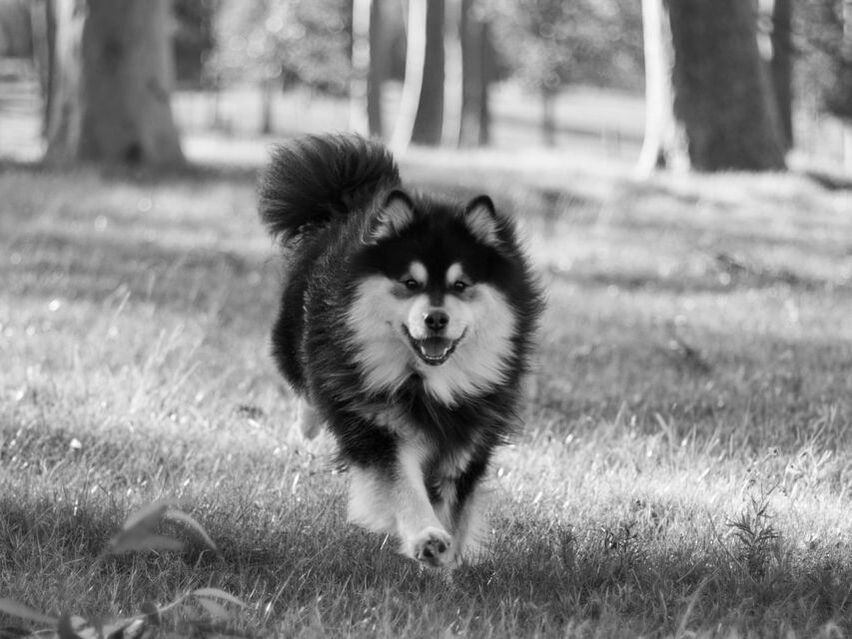|
|
What is lure coursing?Lure Coursing is a newly ANKC recognised dog sport which involves a dog chasing an artificial lure across a field, in a pattern made to simulate a prey animal (e.g. a rabbit) changing direction as it runs away.
The sport was originally developed to test the “eye” of a sighthound (salukis, greyhounds, afghans etc), as well as their speed and agility in chasing down game, which are the breeds’ original purpose, though it has been extended to all ANKC breeds, who compete in different classes to the sighthounds, known as the Coursing Ability Test (CAT) stream. The lure itself is a plastic bag on a string, which is pulled around the course by a specially designed motor. Pulleys are used around the course to act as corners, making the bag change direction suddenly, simulating how a prey animal would run. Each competition has a lure operator, who is responsible for operating the machine which drives the lure around the track as well as a hunt master who controls the proceedings on the field and giving the command to “tally-ho” (release the dog) at the beginning of the course and “retrieve your dog” at the end. Dogs are expected to see the lure “running” away from them and give chase. |
Quick Facts
|
Training level required: ☆ (easy)
Training type: Try Out Days & at home conditioning Equipment cost: $ (inexpensive) |
Overseeing body: Australian National Kennel Council
Minimum age for competition: 15 months Breed restrictions: None! Open to all breeds |
What equipment do I need?Generally people do not own all the gear to lure course as it requires a huge amount of space to set up a course and run the dogs through it. To run a trial, you will need a purpose built lure coursing machine (petrol or electric depending on the need), at least 20 pulleys, several tie downs and a lot of string. If you are just interested in giving the sport a go, you will only need an easily removable lead and collar or a slip lead as dogs run "naked" in lure coursing.
|
Age appropriate exercise
Lure Coursing is a high impact sport. We would be remiss if we didn't include a warning to pet parents about age appropriate exercise and how it applies to the sport. While the minimum competition age for lure coursing is 15 months old, we recommend not using this as a guideline for when your puppy will be competing. There are plenty of great foundation exercises you can do to help your puppy's later lure coursing training, however we only recommend adding the high impact parts of the sport (running full pelt into quick turns) after the age of 15 months. This will help protect your puppy's growing joints, and help to ensure that they have a long career in the sport. We recommend consulting with your vet before starting training to make sure that your puppy's growth plates have closed, and that they are well-muscled, fit and healthy.
|
|
How much training is needed?Lure Coursing is one of the sports that is based on instinct, so there isn't any "training" as such. Away from the lure coursing field, some dogs can be encouraged to run after a plastic bag tied to a moving remote control car, but in general, dogs will either chase the bags, or they won't and the only help we can give them is to ensure that they are fit, healthy and in great physical condition to help prevent injury if they do turn fast and take a spill or trip on course.
Many states run "come and try" days for lure coursing. Attending one of these days is the best way to find out whether or not your dog is a lure coursing prospect. |
Titles
There are two streams of titles for dogs competing in lure coursing. In both streams, dogs start with junior courser (JC) which is a simple pass or fail test, based on whether or not the dog displayed each of the 5 scoring criteria (speed, agility, follow, enthusiasm and endurance). Dogs require two qualifications of 2 runs each (4 runs all up) to earn the JC.
The easier of the two streams, the Coursing Ability Test stream, only has four titles available once the dog is past the JC level. Each of these requires 8 passes where the dog has earned a minimum of 100 points across 2 runs. Once the dog has achieved its CAM, it is able to receive a numbered title for every 8 passes it achieves after it has earned it's Master title eg. CAM4.
The sighthound stream is harder to understand - once sighthounds have achieved their JC, handlers must decide how they want to compete with their dog. They can choose to course their dog on it's own in the singles class, which they can enter immediately after they have achieved their JC, or they can choose to Qualifying Course (QC) their dog (run it with an experienced courser of the same/similar breed) in a test to make sure that the novice dog will not interfere with another coursing dog - achieving a QC will qualify the dog to run with other dogs of the same breed in Open or Veterans Class (if they are above 7 years old for most sighthounds, or 5 years old for Irish Wolfhounds). All 3 classes allow the dogs to accumulate passes (in single stakes) or breed points (in open and veteran stakes) towards their Field Champion titles, but the first 6 passes they achieve in any class will earn them the title of Senior Courser. Each class has it's own Field Championship (open stakes titles have no denotation, singles stakes titles begin with a lower case S and veteran stakes titles begin with a lower case V) and once the hound has achieved a Field Championship in any of the classes they are then able to continue to accrue breed points or qualifications depending on the class to go onto the Lure Courser of Merit title, and then the Lure Courser Excellent title. Additional (numbered) titles eg LCX2 are available for dogs who accrue 50 more breed points for veteran and open stakes, or 8 more passes in single stakes after they have achieved the LCX title.
The easier of the two streams, the Coursing Ability Test stream, only has four titles available once the dog is past the JC level. Each of these requires 8 passes where the dog has earned a minimum of 100 points across 2 runs. Once the dog has achieved its CAM, it is able to receive a numbered title for every 8 passes it achieves after it has earned it's Master title eg. CAM4.
The sighthound stream is harder to understand - once sighthounds have achieved their JC, handlers must decide how they want to compete with their dog. They can choose to course their dog on it's own in the singles class, which they can enter immediately after they have achieved their JC, or they can choose to Qualifying Course (QC) their dog (run it with an experienced courser of the same/similar breed) in a test to make sure that the novice dog will not interfere with another coursing dog - achieving a QC will qualify the dog to run with other dogs of the same breed in Open or Veterans Class (if they are above 7 years old for most sighthounds, or 5 years old for Irish Wolfhounds). All 3 classes allow the dogs to accumulate passes (in single stakes) or breed points (in open and veteran stakes) towards their Field Champion titles, but the first 6 passes they achieve in any class will earn them the title of Senior Courser. Each class has it's own Field Championship (open stakes titles have no denotation, singles stakes titles begin with a lower case S and veteran stakes titles begin with a lower case V) and once the hound has achieved a Field Championship in any of the classes they are then able to continue to accrue breed points or qualifications depending on the class to go onto the Lure Courser of Merit title, and then the Lure Courser Excellent title. Additional (numbered) titles eg LCX2 are available for dogs who accrue 50 more breed points for veteran and open stakes, or 8 more passes in single stakes after they have achieved the LCX title.
|
|
The first level of competition
Junior CourserThe Junior Coursing (JC) Test is the entry level to the sport for all dogs, regardless of breed. Dogs aren't scored like they are in higher levels, but are instead given a pass or fail based on whether or not the dog has satisfied the five scoring criteria:
When you enter the ring, you will be brought to the start line and told where to stand by the Huntmaster. The Huntmaster will then instruct you to either remove the lead, or get your slip lead sorted so you are able to "slip" your dog when the lure moves. While you are preparing yourself, the Huntmaster will check with the field team (lure driver and judges) to make sure that they are also ready for your dog to run. Once everyone is ready, the Huntmaster will say "do not release your hound before the T in Tallyho" before cueing the lure driver to start the lure. Once the lure is a sufficient distance from the dog so they will not catch it, the Huntmaster will say "tallyho", and you will release your dog to run. It is very important to restrain your dog until the Huntmaster says tallyho, or your dog will lose points. Once your dog has run almost the full course, and is on it's way back to you, the Huntmaster will instruct you to catch your dog, which you should do as soon as possible. The easiest way to do this is to stand close to where the bags will stop, and then grab the dog when they come close. Once you have secured the dog on a lead, you will leave the field. |
|
NSW Breeder Identification Number: B000685661 | Victoria Source Number: EE102260
Dogs NSW Member Number: 2100088743 |
© Pawformance 2023
|
